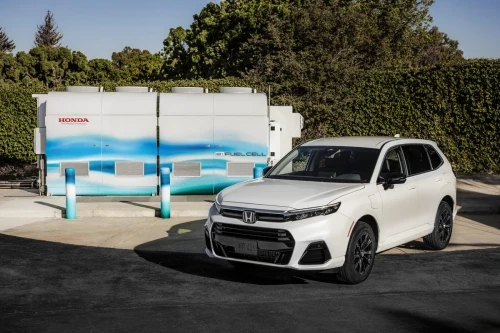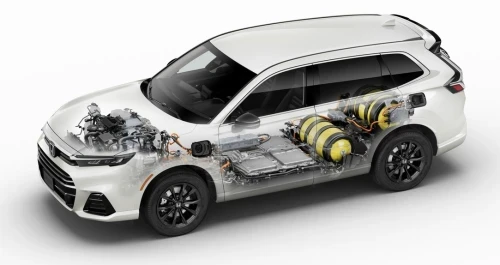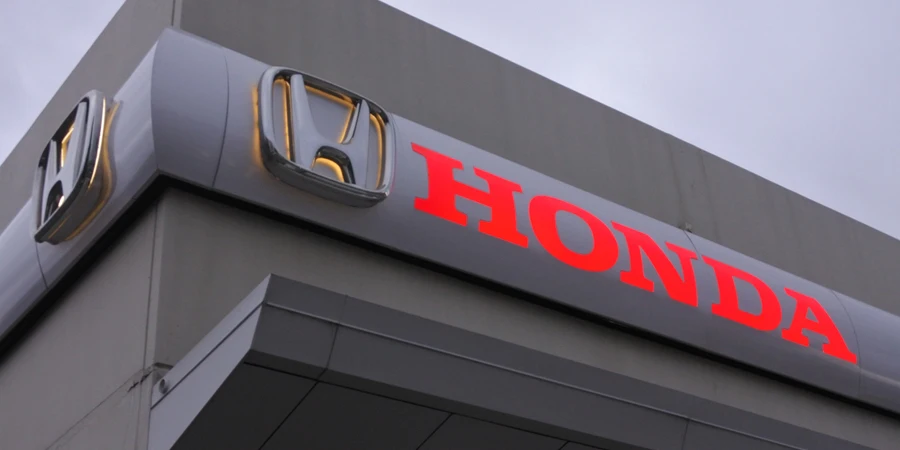Honda announced lease options for the all-new 2025 Honda CR-V e:FCEV, its production plug-in hydrogen fuel cell electric vehicle. The zero-emissions compact CUV will be available in California starting 9 July, with three competitive leasing options, with the majority of customers expected to choose a 3 year/36,000 mile lease for $459 per month, including $15,000 of hydrogen refueling credits during the lease term.

The 2025 Honda CR-V e:FCEV has received a 270-mile EPA driving range rating, combining an all-new US-made fuel cell system along with plug-in charging capability designed to provide up to 29 miles of EV driving around town with the flexibility of fast hydrogen refueling for longer trips.

Retail leasing of the CR-V e:FCEV is available through a network of 12 approved Honda dealerships in select California markets, including six dealerships in Southern California (Los Angeles and Orange County areas), five in the San Francisco Bay Area, and one in the Sacramento area.
| 2025 Honda CR-V e:FCEV Lease Options | |||
|---|---|---|---|
| Monthly payment | $459 | $389 | $489 |
| Due at signing | $2,959 | $2,889 | $2,989 |
| Lease term | 3 years | 6 years | 2 years |
| Allowable mileage | 36,000 | 72,000 | 60,000 |
| Hydrogen fuel credit | $15,000 | $30,000 | $25,000 |
The lease terms also include up to 21 days of access to a rental vehicle from Avis while in California, 24/7 roadside assistance, and eligibility for California’s Clean Air Vehicle Stickers to allow single-occupant HOV access. The 2025 Honda CR-V e:FCEV lease options are based on a Manufacturer’s Suggested Retail Price (MSRP) of $50,000, though no purchase option will be offered.
Every CR-V e:FCEV is very well-equipped and includes a 10.2-inch digital instrumentation display, 9-inch touchscreen, wireless Apple CarPlay and Android Auto compatibility, wireless phone charging, a 12-speaker Bose premium audio system, power adjustable heated front seats, heated steering wheel, dual zone climate control, handsfree access power tailgate, parking sensors and sustainable materials including bio-based leather seat upholstery.
Standard features alsoinclude HondaLink with expanded capabilities including hydrogen station information in addition to charging and power supply data. For additional convenience, the included Honda Power Supply Connector features a 110-volt power outlet that can deliver up to 1,500 watts of power, turning CR-V e:FCEV into a clean power source capable of running small home appliances, portable air conditioners, power tools, camping equipment and more.
Honda has more than two decades of market experience with hydrogen fuel cell vehicles, starting from the introduction of the Honda FCX in December 2002, the first zero-emission fuel cell electric vehicle (FCEV) to receive certification for everyday use from both the US Environmental Protection Agency (EPA) and the California Air Resources Board (CARB), as well as the first FCEV leased to individual customers.
The 5-passenger CR-V e:FCEV is built at Honda’s Performance Manufacturing Center in Marysville, Ohio, and is the only fuel cell electric passenger vehicle made in America, using domestic and globally-sourced parts. The CUV is the first application of the second-generation Honda Fuel Cell Module, which is produced at Fuel Cell System Manufacturing, LLC (FCSM) in Michigan, offering significantly improved durability, higher efficiency, increased refinement and lower cost compared to Honda’s previous generation fuel cell system.
Co-developed with General Motors, the next-generation Honda Fuel Cell Module reduced cost by two-thirds compared to the cost of the fuel cell system in the Honda Clarity Fuel Cell. This significant cost reduction was achieved by various measures including the adoption of innovative materials for electrodes, advancement of a cell sealing structure, simplification of the supporting equipment and the improvement of productivity.
Source from Green Car Congress
Disclaimer: The information set forth above is provided by greencarcongress.com independently of Alibaba.com. Alibaba.com makes no representation and warranties as to the quality and reliability of the seller and products.




